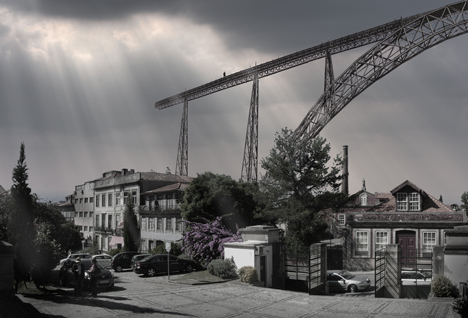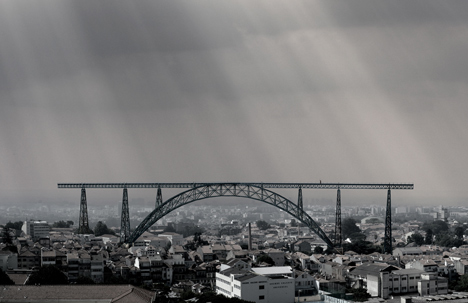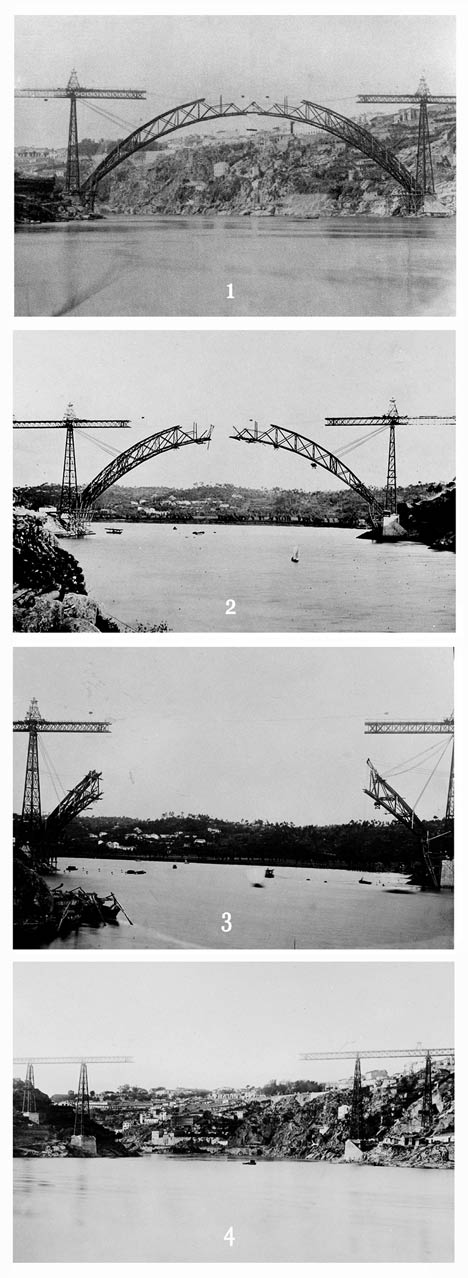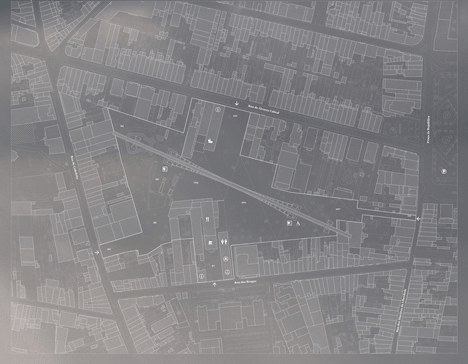Portuguese architects want to relocate Porto's Maria Pia Bridge
News: two Portuguese architects want to transform Porto's iconic Maria Pia Bridge, built in 1877 by Gustave Eiffel, into a monument by moving the disused structure from its present location on the River Douro to the city centre.
Designed by the French engineer of Eiffel Tower fame, the wrought-iron railway bridge has been out of use since 1991. However, as one of Porto's most recognisable structures, Pedro Bandeira and Pedro Nuno Ramalho believe it could help the city establish its international identity.
"The relocated D. Maria Pia Bridge would bring a new monumentality to the city," reads the architects' proposal. "The bridge would be a monument of the deindustrialisation, where the materiality of the nineteenth century gives place to the contemporary immateriality."

Bandeira and Ramalho entered the proposal in a competition seeking ideas to revitalise the Aurifícia area in central Porto. Although it didn't win, the architects insist it could still become a catalyst for urban regeneration.
"By relocating [the bridge] to the centre of the city on a higher position, [it] would regain visibility but mostly another meaning, since it is released of the need of being useful," they said.

According to the plans, the bridge's latticed girder structure could be easily dismantled. It could then be re-erected over a period of five months, with a budget of less than €10 million (£8.5 million).
Local journalist Ana Laureano Alves believes the project addresses some of the most important issues facing contemporary architecture.
"Although it may seem extreme in a first moment, I believe that it is an intelligent proposal," she told Dezeen. "On one hand it is a call for attention of the failure of the urban regeneration policies and, on the other, it is a provocation to the contemporary approach on monuments and history."

The bridge currently spans the River Douro in the south-east of the city. With a height of 60 metres and a 353-metre span, it was once the longest single-arch span in the world.
Here's a project description from the architects:
Relocation of the D. Maria Pia Bridge
Two architects, Pedro Bandeira and Pedro Nuno Ramalho proposed the relocation of the Eiffel's D. Maria Pia Bridge to the city centre, exposing its actual uselessness (not in use since 1991) and drastically changing the skyline of Oporto.
This proposal was a response for a call of ideas for the urban regeneration of the block Aurifícia in the city of Oporto, Portugal, promoted by the Portuguese Council of Architects. As it seems obvious, it did not win. If at a first glance it looks like as an ironic proposal of nonsense humour, it has also a deeper meaning. This strong gesture would establish a particular identity of the city, unique, bizarre and appealing. It may seem absurd, but in some way it just reflects the absurd that the city already is: the decadent urban landscape that invites the tourists to photograph the building in ruins, abandoned warehouses and factories; a scenario that no urban regeneration policy was able to reverse.

Since 1991 the D. Maria Pia Bridge is not at use. With the two new bridges over the Douro River – the Infante Bridge and the S. João Bridge - it lost its scale and dignity; it is hidden and forgotten. By relocating it to the centre of the city on a higher position, the bridge would regain visibility but mostly another meaning, since it is released of the need of being useful. The proposal rescues the beautiful expression "work-of-art" used in some languages by the engineers to refer to the construction of bridges. The originality of the solution would contribute, in a first moment, for increasing tourism and consequently the development of other services. Aside from that, it is more significant the boost of the city's identity, nourishing the self-esteem of its inhabitants, the fundamental actors on the revitalisation of the city. Astonishingly, the project would be easily executed, both in the constructive and in economical terms. The lattice girder structure of the bridge is light and easily disassembled. It would require around five months for the entire process of construction and a budget of less than 10 million of euros, eight times less than the costs of Koolhaas' Casa da Música, located in the vicinity. As the Eiffel Tower, the relocated D. Maria Pia Bridge would have a significative impact, contributing for promoting the image of the city worldwide.

The relocated D. Maria Pia Bridge would bring a new monumentality to the city. New, considering it is far from the classical sense of the expression, as of institutionalisation of History. It is a transgressive monumentality that aims for its permanent actualisation meaning, reflecting the present conscious of its fragility. The Bridge would be a monument of the deindustrialisation, where the materiality of the 19th century gives place to the contemporary immateriality, where there is no space for a bridge that connects just two places. The bridge died, but it died standing, like a tree.